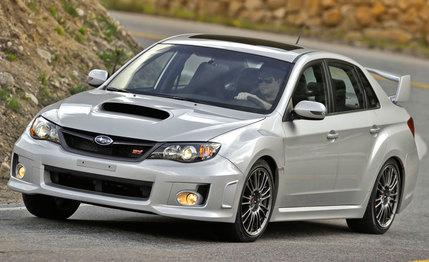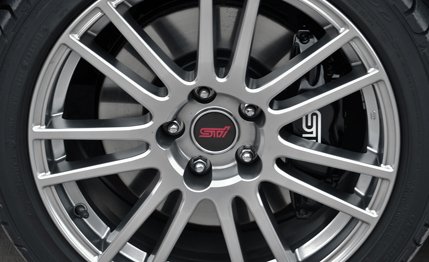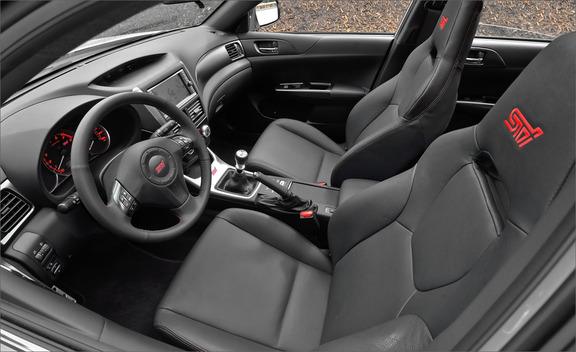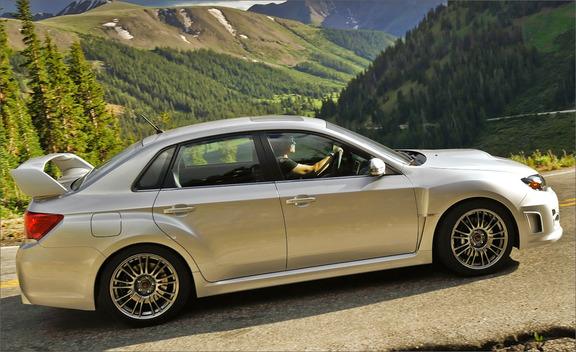 First Drive Review
First Drive Review
Click here to read our first drive of the updated 2011 Subaru WRX.
Progress is a wonderful thing. Its forward march has brought us wonders as extraordinary as sliced bread, democracy, and the Shake Weight, the bizarre as-seen-on-TV product that dubiously compacts an everything-toning workout into just six minutes a day. And now, for 2011, progress yields a sharpened Impreza WRX STI that addresses some longstanding complaints about its handling.
Taking the modifications responsible for the 2010 STI Special Edition a few steps further, Subaru’s STI engineers aimed to improve grip, steering accuracy, and aerodynamics while reducing body roll and understeer. We can speak to their success in four of those five categories and will have to take their word on the aero part. (Progress has not yet afforded us a portable wind tunnel. We’re still waiting.)
The suspension overhaul starts up front with the same 16-percent-stiffer springs from the Special Edition. Pillow-ball bushings replace hard-rubber pieces in the front lower suspension arms, which translates to less fight in the steering, making it easier to hold a constant steering angle through turns and clarifying communication from the road surface. The pillow-ball bushings also get a nod for the reduction in understeer we observed, as the STI now plows less as you head for an apex. The front suspension changes allowed for stiffer rear springs—53 percent firmer compared with those of the standard 2010 STI, which surpasses the 29-percent increase granted to the Special Edition—as well as stiffer rear subframe bushings. Finally, the front and rear anti-roll bars each gain a millimeter of thickness, now measuring 21 and 19 mm, respectively, and they shore up body roll compared with last year’s car. A few back-to-back laps at the former Aspen International Raceway (now part of the Aspen Racing and Sports Car Club in—surprise!—Aspen, Colorado) with 2010 and 2011 cars confirmed that the changes have made a noticeable if not dramatic difference.

All 2011 STIs get a 0.2-inch ride-height reduction that Subaru claims is responsible for the better aerodynamics. A little surprisingly, the handling-enhancing changes, along with retuned dampers, seem to have actually improved ride quality. We say “seem” since we have yet to put the 2011 STI through the torture test of our local roads.
Subie says grip is up for the 2011 car; the last STI we tested, our 2008 long-termer, scored 0.93 g, so we’ll see if we can’t better that number when we get a 2011 to the test track. The standard cast wheels save four pounds each over the 2010 car’s, and the lighter-still BBS wheels are again available, although they’re now painted dark silver instead of bright silver or the iconic gold.

The drivetrain is untouched, as progress apparently wasn’t needed in the engine room. (If it were up to us, we might have asked for better reliability; our long-termer required a new short block during its stay.) As before, the STI couples its 305-hp turbocharged flat-four solely with a six-speed manual transmission. SI-Drive is still included, allowing the driver to fine-tune the throttle response. And the all-wheel-drive system’s multiple modes can tailor lockup for any situation, doing so automatically or letting the driver choose a center-differential locking level manually.
Looks More Good
The STI has progressed enough to revisit the past: The new model year resurrects the four-door-sedan body style, so 2011 will be the first year that an STI sedan and hatch are offered simultaneously, following the car’s switch to hatch only when this generation was launched for 2008. The sedan’s touted advantage is in its aerodynamic efficiency, which Subaru says allows a top speed of 158 mph, 3 ticks more than the five-door’s. But cargo capacity takes a 7.7-cubic-foot hit from the hatch’s 19 cubic feet behind the rear seats. (The back seats in both models fold.) The sedan is 6.5 inches longer and weighs marginally more—a difference of 11 pounds, according to Subaru. These are minor differentiators, so choose which one you like looking at most. (A few in our office like the looks of the sedan, but all agree the hatch is more practical.)

The sedan and the hatch benefit from more aggressive front-end styling for ’11; the grille has been blacked out and dips lower into a more muscular front fascia. The sedan’s rear matches the hatch’s width and features the expected massive wing atop the trunklid. Inside, the stereo sees technological progress, getting an upgrade with standard Bluetooth, auxiliary, and iPod/USB connectivity. Limited models, which are sedan only, include leather seats, a sunroof, fog lights, and the lightweight forged BBS wheels. There’s now an included All-Weather package that bundles heated front seats, heated side mirrors, and windshield-wiper defrosting. Nor’easters—not the storms, but rather the people who suffer from them—will be pleased.
One More Sedan Advantage: Price
The 2011 four-door starts at $34,720, so it lowers the STI entry fee by a couple of grand compared with the 2010 car. The Limited sedan adds the aforementioned leather, wheels, fog lamps, and sunroof, commanding an extra $3350. STI hatchbacks come in one trim level, starting at $36,720. That’s a $1030 increase from the 2010 STI base price, the difference largely being made up by the BBS forged wheels becoming standard here, too (formerly a $2000 option). A navigation system that replaces the head unit with a seven-inch touchscreen remains the sole factory option.
Of course, the big question is whether the 2011 STI has separated itself once again from its WRX little brother, which also is updated for next year. The plain 2011 WRX makes its progress in the styling department, inheriting the STI’s wide-body sheetmetal and revised grille shape, and the two now look nearly identical to each other. Considering that and the fact that the WRX will likely continue to be the quicker car to 60 mph—in our testing, the 2009–10 WRX hit the mark in 4.7 seconds compared with the STI’s 5.0—we think it’s tough to justify the STI’s $8500 premium. For the extra money, you get SI-Drive, some STI-only structural reinforcements, and a more advanced AWD system with an electronically adjustable center differential, but that stuff really only pays dividends on a rally stage or racetrack.

So, although progress has touched the STI in some real, beneficial ways, those who stick to the highways and byways should probably go with the 2011 WRX. You get the STI’s muscular look and most of its strengths, and a not-inconsequential sum remains in your pocket. Similar advice could apply to those creepy Shake Weights—save your $19.95 (plus shipping and handling!) and grab a three-dollar gallon of milk and start shaking away. The benefits are likely to be the same, and if you add some ice cream, you’ll at least end up with a tasty milkshake.